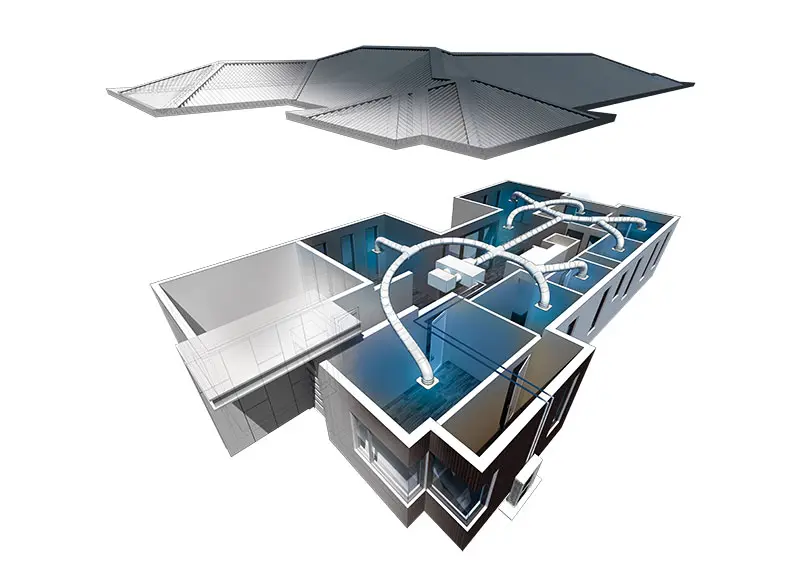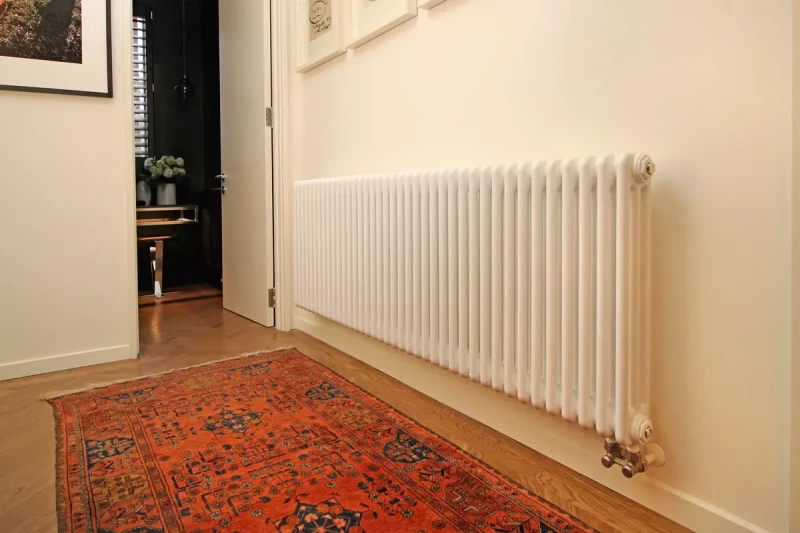Space heating accounts for around a third of the energy bill for a home in New Zealand, picking a system that can do this effectively and efficiently can have a big influence on the running costs of a home. For homeowners that want to heat a large amount or all of their home, there are 2 options typically considered in New Zealand: a ducted forced air system or a warm water radiant system.
So what are the differences between these systems and how does this affect the comfort levels and efficiency of a home’s heating?
Ducted Central Heating:
A ducted system is typically heat pump or gas powered and consists of a central unit mounted in the roof space. Air is drawn out of the home through one or more ceiling vents and is then heated, and blown back into the home through outlet vents located in each room.

Benefits:
- Heat pump systems also provide effective cooling
- Can often be easily retrofitted (added to an existing home)
- Often cheaper to install
Cons:
- Drafts from vents can be noticeable and uncomfortable
- Higher temperatures are required to combat draft and effective heat stratification
- The fan and outdoor unit create noise
- Can struggle to heat in very cold conditions
- Heat pump systems defrost using room air causing cold air to be blown into the home during the defrost cycle
- Space required in ceilings, walls, and roofs for ducts and grilles
- Limited energy source options, only heat pump, and gas
- Dust and allergens collect in the ducting pipes and can be spread around the home (regular cleaning needed).
Warm Water Central Heating:
Warm water-based heating systems often deliver heat to the home via natural convection and radiant heating methods, typically this is via wall-mounted radiators or underfloor heating. The warm water is heated at a central place either by either a gas, diesel or biomass boiler, or by a heat pump. A pipe network throughout the home allows the heat to be delivered where it is needed and evenly spread out. These pipes are much smaller than the ducts used in ducted systems and lose less heat due to the smaller surface area.

Benefits:
- No source of noise inside the home as no fans are used
- Even heat throughout the home with heat radiating from the ground up
- No drafts and reduced stratification so lower room temperatures feel comfortable
- Radiant heating from underfloor is more comfortable
- Floor heating is invisible with only a thermostat located in the home
- Many options for the heat source, heat pumps, gas, diesel, and solid fuel
- Can be integrated to also heat the homes hot water
- Defrosting cycles of heat pump systems are not noticeable inside.
- The long life expectancy of built-in components (pipe life >50 years)
- Water transfers heat at 4 times the rate of air making it more efficient to move the heat around the home
Cons:
- Underfloor heating needs to be run throughout the heating season
- Can be more expensive to install
- Can be difficult to retrofit
- Cooling options are limited
Running Costs:
Warm water-based central heating systems can provide a significant reduction in the energy demands of home heating, this is different for every home but typically the following factors apply;
- Radiant and natural convection heating is more comfortable at lower temperatures, as a guide, for every 1°C lower a heating system is set, the running cost reduces by 10%.
- Heat pump systems can defrost more effectively when using some of the energy from the water leaving more time for heating the building.
- Lower temperatures required to deliver heating increase the efficiency of the heat sources.
- Lower system losses with small insulated pipe compared to large ducts.
- Efficient distribution of heat around the building with a circulation pump that will use around 10% of the energy of a fan to blow enough air around to have a similar effect.
When comparing a heat pump-powered ducted system to a heat pump-powered underfloor heating system the annual running costs of the underfloor heating system can be around 20% less with a higher level of comfort achieved.
Home Health:

One of the most important benefits of a warm water radiator or underfloor heating system is the reduction in transmission of dust, odours, and airborne bacteria and viruses in the home. Ducted systems can spread these throughout the home which can cause allergies and illness to spread more easily. These systems are difficult to clean and contamination can build up over time resulting in poor performance or the need to replace ductwork.
Warm water/radiant systems do not force air to move around the home and instead provide a gentle, radiant warmth in your home. It’s so comfortable that you forget it’s there until you step out of your home into the cold weather.
Fernox inhibitors are put into every Central Heating New Zealand system to protect the components and enhance the life of the system.






